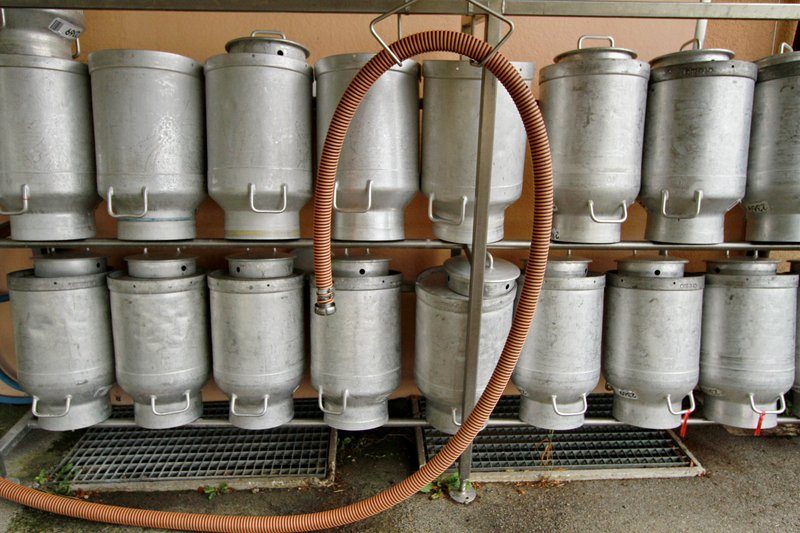Structure of agricultural holdings, 2023
From 2023 on, the structure of agricultural holdings will be monitored according to an altered methodology
In 2023, almost 1 % fewer holdings than in 2020 are cultivating 5 hectares or more of utilised agicultural area, but they manage 3 % more land. From 2023 on, the data on the structure of agricultural holdings are monitoring a different population, incomparable with the past data.
The structure of agricultural holdings data are published according to a new methodology
The new methodology is the result of a revised legislation that came into effect in 2020 (more in the methodological note). The data are not directly comparable with previous data on the structure of agricultural holdings. To assure comparability between 2020 census and 2023 data, we recalculated the 2020 census data according to the new methodology that took place in 2023. Therefore, all subsequent comparisons refer to such data conversion.
More than 2% larger utilised agricultural area than in 2020
In 2023, of the 447,158 hectares of utilised agricultural area, the largest share was permanent grasslands (56% or 250,705 hectares), followed by arable land (38% or 170,495 hectares) and permanent crops (6% or 25,959 hectares). The total utilised agricultural area increased by more than 2% compared to 2020 on observed agricultural holdings.
According to the new methodology, an average agricultural holding in Slovenia manages 8.8 hectares of utilised agricultural area, meaning 5.0 hectares of permanent grassland, 3.4 hectares of arable land and 0.5 hectares of permanent crops.
Size classes of the utilised agricultural area (UAA) show that the number of agricultural holdings increased compared to 2020 in the class from 20 hectares and more of UAA, namely from 3,815 to 4,294 agricultural holdings (by 13%). The UAA also increased by a similar share, 13%, in that class: it amounted to 182,413 hectares. The number of agricultural holdings decreased compared to 2020 in the class from 5 to below 20 hectares of UAA, namely from 23,489 to 22,854 (by 3%). The UAA also decreased from 216,353 to 207,155 hectares (by 4%). In the class below 5 hectares the number of agricultural holdings decreased by 14%, from 27,295 to 23,383, and the UAA by 2%, from 58,588 to 57,590 hectares.
The total number of agricultural holdings decreased by 7% from 54,599 to 50,531 compared to the year 2020.
In the structure of livestock production more poultry and breeding animals; the number of cattle is in decline
Comparing data on livestock production between 2020 and 2023, it should be taken into account that the number of livestock for 2020 was collected on a different reference day (1 February 2020) than in 2023 (1 June 2023). Because the number of animals in individual categories changes seasonally, the comparisons regarding sheep and goats are focused on the breeding categories of animals, which are more stable during the year.
In 2023, observed agricultural holdings are raising more poultry (by 7%), breeding sheep (by 3%) and breeding goats (by 9%) than in 2020. The number of agricultural holdings where the listed animals are bred also increased.
The most numerous type of livestock on farms is poultry, as it counts 7,453,688 animals, which is 7% or 481,025 animals more than in 2020. There are also more agricultural holdings where poultry is raised (by more than 12% or 2,739 holdings). Cattle is the second most numerous type of livestock, as it counts 445,625 animals, which is 6% or 27,804 animals fewer than in 2020. There are also fewer agricultural holdings where cattle is raised (by 9% or 2,296 holdings). Out of all cattle, there are about 6% fewer cows than in 2020 and 14% or 2,896 fewer agricultural holdings where cows are bred.
Compared to the year 2020, the number of pigs decreased by 15% from 233,317 to 194,068, while the number of agricultural holdings breeding pigs increased from 11,103 to 12,895 (by 16%).
On the other hand, in 2023 there are 3% more agricultural holdings breeding sheep (74,194) and 9% more breeding goats (18,674) than in the year 2020. Sheep are bred on 4% more holdings (4,219) and goats on less than 1% more holdings (2,530).
The new methodology is the result of a revised legislation that came into effect in 2020 (more in the methodological note). The data are not directly comparable with previous data on the structure of agricultural holdings. To assure comparability between 2020 census and 2023 data, we recalculated the 2020 census data according to the new methodology that took place in 2023. Therefore, all subsequent comparisons refer to such data conversion.
More than 2% larger utilised agricultural area than in 2020
In 2023, of the 447,158 hectares of utilised agricultural area, the largest share was permanent grasslands (56% or 250,705 hectares), followed by arable land (38% or 170,495 hectares) and permanent crops (6% or 25,959 hectares). The total utilised agricultural area increased by more than 2% compared to 2020 on observed agricultural holdings.
According to the new methodology, an average agricultural holding in Slovenia manages 8.8 hectares of utilised agricultural area, meaning 5.0 hectares of permanent grassland, 3.4 hectares of arable land and 0.5 hectares of permanent crops.
Size classes of the utilised agricultural area (UAA) show that the number of agricultural holdings increased compared to 2020 in the class from 20 hectares and more of UAA, namely from 3,815 to 4,294 agricultural holdings (by 13%). The UAA also increased by a similar share, 13%, in that class: it amounted to 182,413 hectares. The number of agricultural holdings decreased compared to 2020 in the class from 5 to below 20 hectares of UAA, namely from 23,489 to 22,854 (by 3%). The UAA also decreased from 216,353 to 207,155 hectares (by 4%). In the class below 5 hectares the number of agricultural holdings decreased by 14%, from 27,295 to 23,383, and the UAA by 2%, from 58,588 to 57,590 hectares.
The total number of agricultural holdings decreased by 7% from 54,599 to 50,531 compared to the year 2020.
In the structure of livestock production more poultry and breeding animals; the number of cattle is in decline
Comparing data on livestock production between 2020 and 2023, it should be taken into account that the number of livestock for 2020 was collected on a different reference day (1 February 2020) than in 2023 (1 June 2023). Because the number of animals in individual categories changes seasonally, the comparisons regarding sheep and goats are focused on the breeding categories of animals, which are more stable during the year.
In 2023, observed agricultural holdings are raising more poultry (by 7%), breeding sheep (by 3%) and breeding goats (by 9%) than in 2020. The number of agricultural holdings where the listed animals are bred also increased.
The most numerous type of livestock on farms is poultry, as it counts 7,453,688 animals, which is 7% or 481,025 animals more than in 2020. There are also more agricultural holdings where poultry is raised (by more than 12% or 2,739 holdings). Cattle is the second most numerous type of livestock, as it counts 445,625 animals, which is 6% or 27,804 animals fewer than in 2020. There are also fewer agricultural holdings where cattle is raised (by 9% or 2,296 holdings). Out of all cattle, there are about 6% fewer cows than in 2020 and 14% or 2,896 fewer agricultural holdings where cows are bred.
Compared to the year 2020, the number of pigs decreased by 15% from 233,317 to 194,068, while the number of agricultural holdings breeding pigs increased from 11,103 to 12,895 (by 16%).
On the other hand, in 2023 there are 3% more agricultural holdings breeding sheep (74,194) and 9% more breeding goats (18,674) than in the year 2020. Sheep are bred on 4% more holdings (4,219) and goats on less than 1% more holdings (2,530).
Average utilised agricultural area on agricultural holding, 2020 and 2023
1) Provisional data
Utilised agricultural area, Slovenia
1) Provisional data 2) Common grassland is not included. | |||||||||||||||||||||||||||||||||||||||||
Number of animals, Slovenia
1) Provisional data | |||||||||||||||||||||||||||||||||||||||||||||||||||||||
Agricultural holdings by utilized agricultural area (UAA) size class, Slovenia
1) Provisional data Common grassland is not included. | ||||||||||||||||||||||||||||||||||
METHODOLOGICAL NOTE
As of 2020, EU Regulation No. 2018/1091 of the European Parliament and of the Council of 18 July 2018 on integrated farm-level statistics in Annex 2 sets new thresholds for the inclusion of agricultural holdings in the sample framework and repeals Regulation (EC) No. 1166/2008.
The new regulation specifies a changed selection of units or, more precisely, new thresholds, which, starting in 2023, determine which agricultural holdings are monitored within the framework of surveys on the structure of agricultural holdings. In 2020, the old thresholds were taken into account. In 2023, however, the new thresholds are fully taken into account.
Agricultural holdings included in the sampling frame in 2000, 2003, 2006, 2010, 2013, 2016 and partially 2020 were those having the physical production above certain criteria:
a) at least one hectare of utilised agricultural area, or
b) less than 1 hectare of utilised agricultural area, but:
For 2023, the data refer to agricultural holdings that meet the following criteria in line with the new EU methodology:
Additional explanations are available in the methodological explanations.
The survey is co-funded by the European Union. Views and opinions expressed are however those of the author(s) only and do not necessarily reflect those of the European Union or Eurostat. Neither the European Union nor the granting authority can be held responsible for them.

The new regulation specifies a changed selection of units or, more precisely, new thresholds, which, starting in 2023, determine which agricultural holdings are monitored within the framework of surveys on the structure of agricultural holdings. In 2020, the old thresholds were taken into account. In 2023, however, the new thresholds are fully taken into account.
Agricultural holdings included in the sampling frame in 2000, 2003, 2006, 2010, 2013, 2016 and partially 2020 were those having the physical production above certain criteria:
a) at least one hectare of utilised agricultural area, or
b) less than 1 hectare of utilised agricultural area, but:
- at least 0.1 hectare of utilised agricultural area and 0.9 hectare of forest, or
- at least 0.3 hectares of vineyards and/or orchards, or
- two or more livestock units (LSU), or
- 0.15 to 0.3 hectare of vineyards/orchards and 1 or 2 LSU, or
- more than 50 beehives, or
- are market producers of vegetables, herbs, strawberries, mushrooms, flowers or ornamental plants.
For 2023, the data refer to agricultural holdings that meet the following criteria in line with the new EU methodology:
- use at least 5 hectares of utilised agricultural area or
- use at least 2 hectares of arable land or
- cultivate at least 0.5 hectare of potatoes or
- cultivate at least 0.5 hectare of fresh vegetables and strawberries or
- cultivate at least 0.2 hectare of aromatic, medicinal and culinary plants, flowers and ornamental plants, seeds and seedlings, nurseries or
- use at least 0.3 hectare of fruit trees, berries, nut trees, citrus fruit trees, other permanent crops excluding nurseries, excluding vineyards and excluding olive trees or
- use at least 0.1 hectare of vineyards or
- use at least 0.3 hectare of olive trees or
- use at least 100 m2 of greenhouses (including all crops under glass or high accessible cover) or
- cultivate at least 100 m2 of cultivated mushrooms or
- breed at least 1.7 livestock units.
Additional explanations are available in the methodological explanations.
The survey is co-funded by the European Union. Views and opinions expressed are however those of the author(s) only and do not necessarily reflect those of the European Union or Eurostat. Neither the European Union nor the granting authority can be held responsible for them.

When making use of the data and information of the Statistical Office of the Republic of Slovenia, always add: "Source: SURS". More: Copyright.

.jpg)

 (1).jpg)
